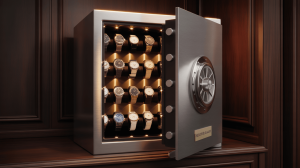Finding a home safe that both secures valuables and keeps automatic watches wound can transform your daily routine. Instead of juggling multiple devices, you gain one solution that offers vault-grade protection, precise winding, and organized storage. This introduction explores why this hybrid approach matters, the benefits it offers, and what key features to consider before making a purchase.
1. Assess Your Security Needs
Start by identifying what you need to protect most. Jewelry, watches, important documents, and small electronics all require different levels of security. If you own high-value items, look for safes with UL RSC or ETL burglary certifications. These ratings confirm resistance against pry tools and drills. For fire protection, choose a model with a UL 72 Class 350 rating, meaning the interior stays below 350°F for at least thirty minutes. Consider whether you prefer biometric access, electronic keypads, or mechanical locks. Finally, decide if bolting the safe to the floor or wall is necessary for extra security.
2. Understand Watch Winding Specifications
Automatic watches need consistent motion to maintain accuracy. Built-in winding modules replicate wrist movement at specific turns-per-day (TPD) settings. Entry-level winders typically offer 650–1,200 TPD, while premium models reach up to 2,000 TPD or more. Direction control—clockwise, counterclockwise, or bi-directional—is essential to match each watchmaker’s specifications. Also look for adjustable pause intervals to prevent over-winding. High-quality Japanese or Swiss motors run under 25 dB, ensuring quiet operation. Rubber-dampened mounts reduce vibration, preserving both motor life and watch health.
3. Evaluate Interior Layout and Capacity
Your safe’s interior must organize jewelry and watches without overcrowding. Look for velvet-lined drawers and removable foam inserts that prevent scratches on metal and gemstones. Ring rolls hold bands upright, while earring posts keep pairs together. Necklace hooks suspend chains, eliminating tangles. Watch pillows fit securely into winding bays. Some models include hidden lower drawers for documents or spare straps. Modular trays let you expand capacity as your collection grows. Balance today’s needs with future additions to avoid outgrowing your safe.
| Interior Feature | Function | Benefit |
|---|---|---|
| Velvet-Lined Drawers | Cushions jewelry and small valuables | Prevents surface damage and tangling |
| Removable Watch Trays | Holds multiple watches for winding | Scalable capacity for growing collections |
| Hidden Lower Compartments | Stores documents, spare straps, or keys | Maximizes space and organization |
4. Inspect Build Quality and Materials
Durable construction ensures long-term protection. Premium safes use 12–14 gauge steel for walls and doors. Continuous weld seams indicate robust assembly. Powder-coat finishes resist scratches and corrosion. Hinges, bolts, and locks should be stainless or chromed alloys that withstand wear. Interior linings of velvet, suede, or leather protect valuables from abrasions. Fireboard or ceramic insulation maintains consistent fire protection. Inspect these elements in person or via detailed specifications to confirm quality.
5. Check Climate and Humidity Control
Humidity and dust can damage both watch movements and jewelry. Look for IP54-rated door seals that block moisture and particles. Passive desiccant chambers absorb residual humidity, while active dehumidifiers maintain 40–50% relative humidity automatically. Digital hygrometers display real-time readings so you can adjust conditions as needed. This stable micro-environment protects leather straps from cracking and precious metals from tarnishing, reducing the need for frequent maintenance or repairs.
6. Compare Smart Connectivity Options
Modern home safes often integrate Bluetooth or Wi-Fi modules. These features send real-time alerts for tamper events, door openings, and low battery. A dedicated smartphone app allows remote lock/unlock and winding schedule adjustments. Audit logs record every access event for full accountability. Enterprise-grade encryption keeps your data secure from hacking attempts. If you travel frequently or want peace of mind, smart connectivity ensures you remain in control, even when away from home.
| Connectivity Feature | Description | Advantage |
|---|---|---|
| Bluetooth Integration | Sends real-time tamper and door access alerts | Immediate notification of security events |
| Wi-Fi Module | Remote lock/unlock, winding controls | Manage settings from anywhere |
| Audit Log Tracking | Records all access attempts and user IDs | Full accountability and traceability |
7. Examine Power Supply and Backup Solutions
Watch winders and electronic locks require reliable power. Most safes include an AC adapter for daily operation and rechargeable lithium-ion battery backup for outages. Verify battery run time—some last a few days, others a few weeks. Low-battery LEDs and app notifications alert you before shutdown. Ensure there’s a hidden mechanical override key or combination dial for manual access if electronics fail. This layered approach prevents lockouts and keeps your watches winding uninterrupted.
8. Measure Noise and Vibration Levels
Even the best winding modules can be disruptive if they hum loudly. Premium motors rest on rubber-dampened mounts and use high-precision bearings to maintain noise under 25 dB—comparable to a whisper. Soft-close hinges prevent slamming sounds, while silent locking bolts reduce clicking. Test noise levels in person or rely on decibel ratings and user reviews to ensure the safe can live in bedrooms, offices, or living rooms without disturbing daily life.
| Component | Specification | User Benefit |
|---|---|---|
| Motor Mounts | Rubber-dampened | Minimizes mechanical vibration |
| Bearings | High-precision | Keeps noise under 25 dB |
9. Plan Installation and Anchoring
Proper installation is crucial for security and stability. First, locate floor joists or wall studs using a stud finder. Use heavy-duty lag or sleeve anchors rated for the loaded weight of the safe. Level the unit before tightening anchors to prevent door binding. Conceal anchor heads beneath the interior liner or trim for a seamless appearance. Professional installation is recommended for larger or heavier safes to ensure correct anchoring and optimal performance.
10. Consider Aesthetic Integration
Your safe should complement home decor. Options include matte-black powder-coat, walnut veneer, or full-grain leather wraps. Beveled glass panels and flush-mount keypads add luxury flair. Built-in LED strips highlight watches and jewelry without generating heat. Motion sensors activate lighting on door opening for a gallery-like reveal. Choose finishes and dimensions that blend with existing furniture and design themes to make the safe feel like a decorative accent rather than an eyesore.
11. Evaluate Maintenance and Care Requirements
Routine care extends both safe longevity and the condition of your valuables. Dust exterior surfaces weekly with a microfiber cloth. Run empty winding cycles monthly to keep motors in top shape. Test locks and electronics quarterly for reliability. Replace desiccant packs every 6–12 months, depending on local humidity. Swap backup batteries annually. Lubricate mechanical locks per manufacturer guidelines. Keep a service log to track maintenance dates and any performance issues that arise.
12. Analyze Budget and Value Proposition
Home safes with built-in winders vary from $1,500 to $10,000+. Entry-level models start around $1,500 for 2–4 winding bays and basic jewelry drawers. Mid-range units ($2,500–$5,000) add climate control, LED lighting, and smart connectivity. Premium safes ($5,000+) feature custom veneers, biometric locks, and extended fire ratings (up to 60 minutes). Factor in insurance discounts for certified burglary and fire protection, which can offset upfront costs. Consider long-term savings on watch servicing and jewelry repair when evaluating total value.
| Price Tier | Range | Core Features |
|---|---|---|
| Entry-Level | $1,500–$2,500 | 2–4 winding bays, basic jewelry drawers |
| Mid-Range | $2,500–$5,000 | Climate control, LED lighting, app |
| Premium | $5,000+ | Custom finishes, biometric lock |
13. Explore Alternatives and Standalone Options
If a hybrid safe exceeds your budget or space, separate devices may work. A standalone watch winder costs $200–$500 for a 2-bay unit. A dedicated jewelry safe runs $300–$800 for moderate capacity. Separate units require more space and two sets of keys or codes. They often lack unified security certification, which can reduce insurance benefits. A hybrid safe consolidates security and convenience into one seamless package, saving space and management effort.
14. Read User Reviews and Brand Reputation
Before finalizing your choice, research real-world feedback. Look for insights on build quality, noise levels, and winding accuracy. Check brand reputation for customer support and warranty coverage. Established manufacturers typically offer longer warranties and responsive service. Note any reports of false alarms or software glitches in smart models. User reviews can highlight strengths and weaknesses that specifications alone might not reveal.
15. Making Your Final Decision
When choosing the right home safe with a built-in watch winder, balance security, winding precision, interior organization, design, and budget. Score each model based on the criteria above. Consider your collection size, style preferences, and tech needs. If you have a large watch portfolio and valuable jewelry, a premium hybrid safe may be worth the investment. Casual collectors might find a mid-range model sufficient. Ultimately, choose the safe that protects your valuables, fits your home, and simplifies your routine.
FAQ
Q1: How often should I run the watch winding modules?
Run winding cycles daily or every other day. This keeps lubricants evenly distributed and maintains accuracy.
Q2: Can I store both quartz and automatic watches?
Yes. Quartz watches remain static in special trays, while automatics sit in winding modules.
Q3: How often should I replace desiccant packs?
Replace desiccant packs every 6–12 months based on local humidity to maintain optimal relative humidity.
Q4: Are smart connectivity features secure?
High-end models use AES encryption and require strong, unique passwords. Regular firmware updates help protect against vulnerabilities.
Q5: Do I need professional installation?
Professional installation is recommended for larger or heavier safes to ensure proper anchoring, stability, and maximum security.







